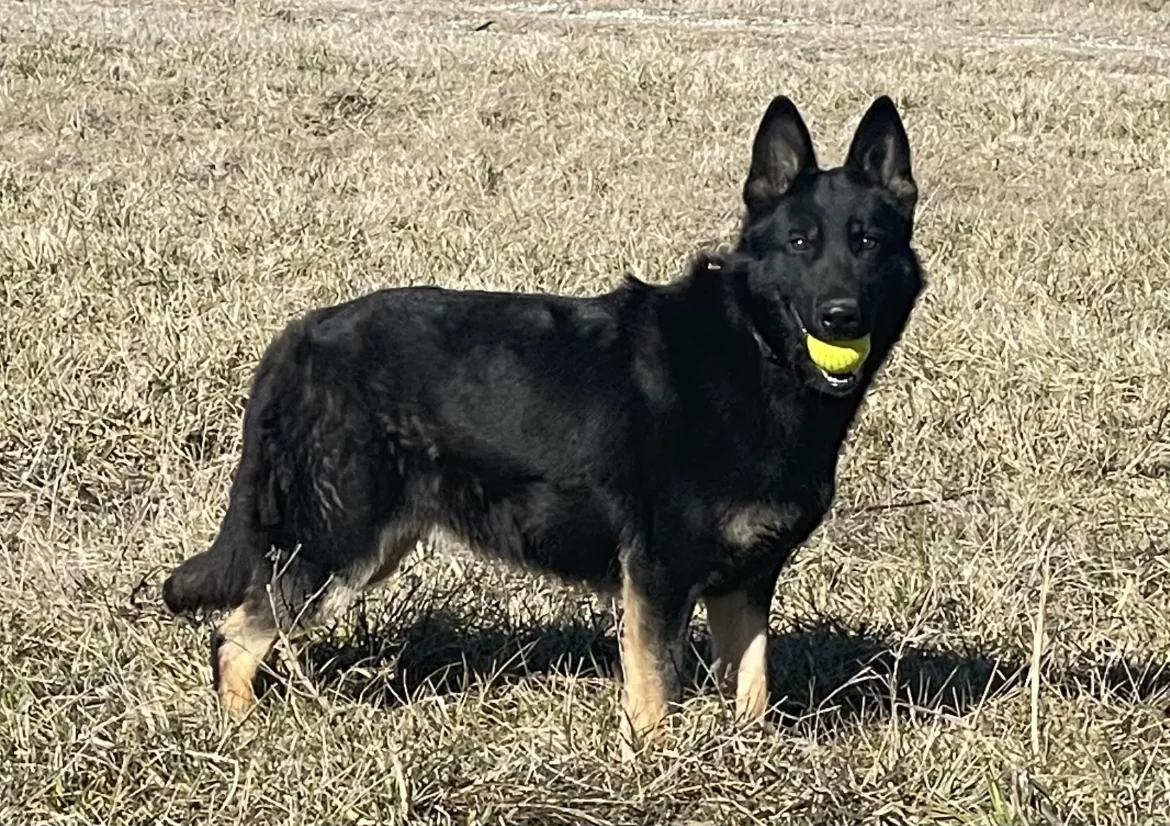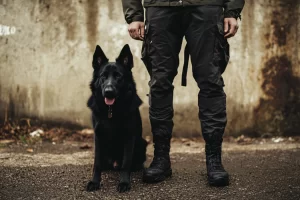Seven Steps to Teaching Your German Shepherd Puppies to Drop a Ball
Here at Czech Working Line, obedience training our German Shepherd puppies is key. Teaching your new puppy to drop a ball on command is a useful skill that enhances playtime and ensures safety. Arguably, this sill is right up there with potty training and teaching your German Shepherd puppy to sit and lay down . It also serves as a foundation for teaching other retrieval-based activities, which are great for the dog’s physical and mental health. Moreover, it strengthens their obedience and responsiveness in a variety of situations, crucial for a breed known for its energy and intelligence. This simple command can prevent dangerous situations where your dog might run into traffic chasing a ball, or it can facilitate playing games that involve retrieving and releasing objects. Additionally, mastering this command helps in further training sessions, as it teaches your dog to follow instructions and builds its trust and willingness to learn. Here’s a comprehensive guide, broken down into seven detailed steps, to effectively teach your German Shepherd to drop a ball on command, ensuring a productive and enjoyable learning experience for both you and your dog.
Step 1: Choose the Right Toy
Your first step is to select a ball or toy that your German Shepherd loves. This toy should be sturdy enough to withstand rough play but safe and comfortable for your dog to carry in its mouth. Avoid overly small toys that could pose a choking hazard or those made from materials that could break apart and be ingested. Additionally, the toy should be appealing enough to capture and keep your dog’s attention without causing excitement that’s too hard to control. Bright colors or toys that make sounds may be particularly engaging for German Shepherd puppies. Picking the right toy is paramount because it becomes a pivotal part of training; it must be something that your dog is naturally inclined to pick up repeatedly. This selection process also helps prevent the dog from developing a preference for unauthorized household items or non-toy objects, which could lead to destructive behaviors or safety issues.
Step 2: Get Your Dog Interested in the Toy
To teach your dog to drop the ball, it first must be interested in picking it up. Initiate play by showing enthusiasm for the toy. Roll it on the ground or toss it a short distance away. Encourage your German Shepherd to chase after the toy. Once your German Shepherd picks up the toy, praise them to reinforce this behavior. This step ensures that your dog not only understands that the toy is for play but also begins to value the toy, making it a useful tool in your training. Engage in interactive games that encourage your German Shepherd to fetch the toy, further building its interest and excitement around the toy. Keep sessions short to maintain high energy and focus. Making the process fun and rewarding from the start will enhance your dog’s eagerness to participate in training sessions, making future steps easier as your dog actively participates knowing that it leads to positive experiences.
Step 3: Introduce the Command
Once your dog is comfortably picking up the toy, introduce the command you want to use, such as “drop it.” It’s crucial to pick a command and stick to it consistently throughout the training process to avoid confusing your dog. Use a firm, yet calm voice when issuing the command. Don’t force the toy out of your dog’s mouth, as this could create a negative association with the command or make your dog possessive of the toy. Instead, use a gentle yet assertive tone that commands attention without causing stress or fear. The timing of the command is crucial; it should be given as soon as your dog has a firm grip on the toy but before they become too settled with holding it. This timing helps ease the process of teaching them to release the toy upon command rather than once they’ve grown too attached or possessive of it during play. This early introduction of the command also sets up a clear structure for the training, making it easier for your dog to understand exactly when and what is expected during these learning moments.
Step 4: Exchange the Toy for a Treat
Hold a treat close to your dog’s nose after issuing the “drop it” command. Most dogs will drop the toy to eat the treat. Immediately give the treat once the toy is released. This exchange reinforces the behavior you want to see following the command. Over time, this teaches your dog that dropping the toy leads to a positive reward, making it more likely they will repeat the action. In the initial stages, use high-value treats to make a strong, positive impression. You can also use affection or a favorite activity as a reward, but treats are typically most effective for immediate results. Be consistent with this reward system to establish a clear and understandable correlation between the “drop it” command and the positive outcomes. As your German Shepherd becomes more adept at responding to the command, you can begin varying the treats and introducing other forms of rewards, such as extra playtime, which strengthens the command through varied positive reinforcement while keeping your dog engaged and interested in the training process.
Step 5: Gradually Reduce the Use of Treats
As your dog begins to reliably drop the toy when given the command, start to delay giving the treat for a few seconds. This teaches your dog to hold the command even without the immediate reward. Continue to praise them verbally and with pats. Gradually, replace treats with these forms of praise until the command alone is enough to get your dog to drop the toy. The gradual reduction of treats teaches your dog to perform the behavior based on command rather than for a treat. Additionally, it fosters a deeper understanding and respect for your commands, as your dog learns to respond without expecting a treat every time. This step is crucial for reinforcing the training in a way that ensures it sticks as a learned behavior rather than just a trick for a treat.
Step 6: Increase Complexity
Once your dog has mastered dropping the toy in a quiet, distraction-free environment, begin adding complexity to the training. Practice the command in different locations and add more distractions, such as other people or dogs. This helps to solidify the command under different circumstances and ensures your dog will follow the command regardless of the environment. Gradually increasing the complexity of the training environment teaches your dog to generalize the command across various situations, a key factor in effective obedience training. This step not only reinforces the command under different conditions but also boosts your German Shepherd puppies confidence and adaptability, which are important traits for a well-rounded, well-behaved dog. Start with slight distractions and slowly work up to more challenging environments, which ensures a smooth transition and prevents any setbacks in training.
Step 7: Practice Regularly
Consistency is key in dog training. Practice the “drop it” command regularly to keep it fresh in your dog’s mind. Integrating the command into playtime turns learning into a fun activity, helping your dog to enjoy the process rather than see it as a task. This also helps reinforce the command as a part of normal interaction with your dog, rather than something that happens only during “training sessions.” Frequent practice solidifies the command as a routine part of your interactions, making it second nature to your dog. It’s also a significant opportunity to spend quality time together, strengthening your bond and improving your dog’s trust and obedience in you. The more fun and rewarding the practice sessions, the more eager your dog will be to participate, helping to build a positive attitude towards training and obedience overall.
Conclusion
Teaching your German Shepherd puppies to drop a ball on command is a straightforward process that enhances your play and training sessions. It not only aids in retrieving games but also ensures that your dog can be controlled in potentially dangerous situations where holding onto an object could be harmful. It requires patience, consistency, and positive reinforcement. By following these seven steps, you create a safe and enjoyable environment where learning is facilitated and encouraged. As your dog masters this skill, you can explore more complex training routines that build on this foundation, enhancing your German Shepherd’s abilities and deepening your bond through shared activities. This step-by-step method not only builds a repertoire of commands that your dog can follow but also establishes a framework for continuous learning and interaction, enhancing your relationship and ensuring your dog’s safety and responsiveness in various situations.




